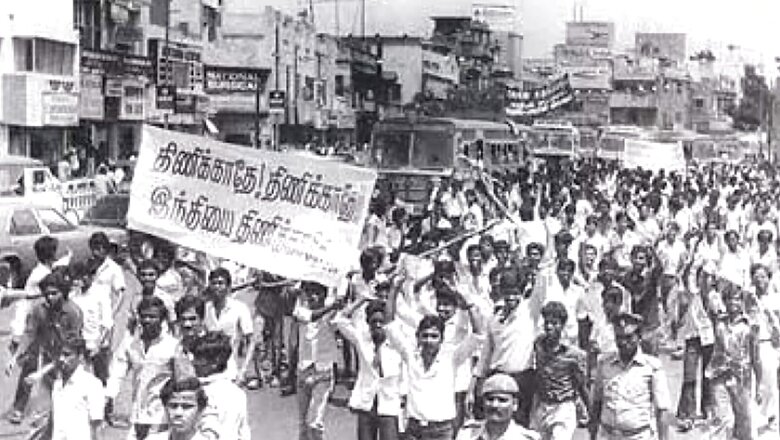
views
So when Kannada actor Sudeep corrected an anchor who addressed the language Kannada as “Kannad”, it was not just about getting the pronunciation right, but a nod towards how the Hindi belt tends to disregard southern India and its languages.
When southern films like Bahubali, Kanthara, Ponniyin Selvan, KGF, and RRR have overtaken Bollywood and are the rage, every south Indian feels a flush of pride and ownership as it helps break away from the false shackles of being called “Madrasi”.
When actors and politicians alike proudly wear the traditional ‘mundu’, ‘veshti’ or lungi as part of their official dressing code, it is another emphatic statement towards those who stereotype and ridicule the southerners.
And now, the great Indian Hindi debate has once again caught momentum when the Parliament’s official language committee chaired by union home minister Amit Shah recommended making Hindi the medium of instruction in all technical and non-technical higher education institutes such as IITs, IIMs, AIIMS, and central educational institutions. It also recommended that Hindi should be one of the official languages of the United Nations.
Voices of dissent emerged as the language issue snowballed into a controversy with the chief ministers of Kerala and Tamil Nadu weighing in. Telangana minister and son of the state’s CM, KT Rama Rao, also raised objections.
Tamil Nadu chief minister MK Stalin, who has written letters to the Centre on the need to stop “Hindi imposition”, has once again reiterated that the Union government’s move could “spark another language war against Hindi” as the state had seen since the late 1930s.
“The BJP is trying to remove English completely from the administration…They want to prevent people from acquiring English knowledge. They say they give importance to state languages only for the sake of speaking. Otherwise, their heart beats only for Hindi. If the claim that the BJP loves other languages is true, are they ready to declare all languages, including Tamil, under the eighth schedule of the Constitution as administrative languages of the Union Government?” Stalin said.
The anti-Hindi sentiment in Tamil Nadu witnessed massive protests which led to violent clashes in 1965. The protests fuelled riots, arson, and clashes that led to around 70 people being killed and major loss of public property with Hindi boards in railway stations or central government offices set on fire. This was against the move by the Centre to make Hindi the sole official language, leading to CN Annadurai declaring January 25, 1965, as a “mourning day”.
Senior DMK leader and Rajya Sabha member TKS Elangovan said that Hindi is not acceptable in a state with a language over 2,000 years old and Tamil culture always practised equality whereas Hindi would reduce Tamils to the status of “Shudras” — a term used to denote the so-called last rung of society in the Hindu varna system.
“They are trying to destroy the culture and trying to impose ‘Manu Dharma’ through Hindi. This should not be allowed. If we did, we will be slaves, ‘Shudras’,” Elangovan said. His remarks came after a comment by another Tamil Nadu minister K Ponmudy mocked Hindi-speaking people, saying it would only help them get jobs like “paani-puri waalas”, which is predominately a Hindi-speaking business class.
Pinarayi Vijayan, the chief minister of Kerala, called the union government’s alleged Hindi imposition a “callous move and an affront to cooperative federalism”, and asked for it to be opposed unitedly. “Union Govt’s Hindi Imposition move is an onslaught on India’s cherished ideal, unity in diversity. It will disadvantage a vast majority of Indians in matters of education and employment,” Vijayan tweeted.
In his letter to Prime Minister Narendra Modi, Vijayan said Hindi cannot be imposed as the main language of instruction in the higher centres of learning as India has many languages and a single language cannot be termed as the country’s language. Most people are conversant with basic Hindi phrases, but it ends with that.
It is also interesting, however, that at a time when Kerala is focused on resisting the central government’s efforts to popularise Hindi, a gram panchayat in Kozhikode district will soon be the first local body in the state to achieve total literacy in the language.
Telangana’s minister for municipal administration and urban development weighed in, stating that the NDA government at the Centre has been flouting the federal spirit. “India does NOT have a National language & Hindi is one among the many official languages To impose Hindi by way of mandating in IITs & central Govt recruitments,” KTR tweeted.
Under the Official Languages Act of 1963, Indian states have been divided into three categories based on the progressive usage of Hindi. Category ‘A’ includes states like Uttar Pradesh, Bihar, Madhya Pradesh, Chhattisgarh, Uttarakhand, Jharkhand, Haryana, Himachal Pradesh, Rajasthan, Delhi, and Andaman and Nicobar Islands. In Category ‘B’ the states of Gujarat, Maharashtra, Punjab, and the Union Territories of Chandigarh, Dadra and Nagar Haveli and Daman and Diu fall, while the rest of India is categorised as ‘C’. Now, two members of the panel have clarified that the mandatory use of Hindi doesn’t cover the Category B and C states where Hindi is not the language used for regular communication.
However, it is also important to cut the political clutter and read the recommendations by the panel in their true spirit.
The crux of the parliamentary committee on official languages’ recommendations submitted to President Droupadi Murmu is to “reduce the usage of the English language in official communication” and it does not impose the language on non-Hindi speaking regions keeping in mind the tenets laid down by the new education policy.
The panel has recommended that Hindi should be given a respectable place in ‘A’ category states and it should be used 100 per cent. The medium of instruction in IITs, central universities, and Kendriya Vidyalayas in Hindi-speaking states should be Hindi and in other parts of India their respective local language, apart from saying that Hindi should be made one of the official languages in the United Nations.
The panel also deemed it important to take a serious view of central government officers and employees who do not use Hindi in Hindi-speaking states. It has recommended that the state government warn such officials that if they continue to be reluctant in using Hindi, it would reflect in their Annual Performance Assessment Report (APAR). So, according to the panel, English as a medium of instruction should be retained only where it’s necessary and gradually replaced by Hindi.
While one’s mother tongue should be given absolute importance during a child’s formative stage, exposure to the different, vibrant languages of India only further empowers oneself. As a south Indian who speaks more than nine Indian languages, including my mother tongue which is a dialect unique to Kerala, the power of being able to communicate with others in their tongue has only helped me appreciate and respect people, their culture, and their traditions better.
Read all the Latest India News here

















Comments
0 comment